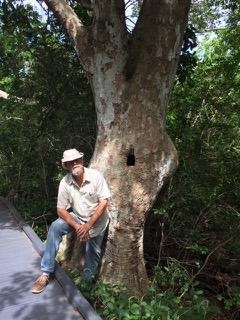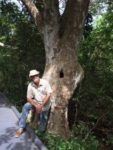
Audubon Everglades Presents
Richard Moyroud, Owner, Mesozoic Landscapes, Inc., Lake Worth, FL
“Old Growth Forest in Palm Beach”
Tuesday, May 4, 2021 at 7:00PM
Zoom-Hosted Presentation (advance registration required)
In 1981, Richard established Mesozoic Landscapes, Inc. specifically to research, grow and promote plants native to South Florida. He is active in plant propagation, consulting, restoration landscape design, and writing. And much, much more.
Among his many published writings, he is co-author of Xeric Landscaping with Florida Native Plants, a guide to using native plant communities as the basis for environmentally-sound landscape design. First published in 1991, it is still in print and widely used.
An excellent example of his native and restorative landscaping work is the Hypoluxo Hammock. This coastal hammock park was dedicated on March 9,1996 and is easily viewed on the south side of the Hypoluxo Town Hall.
Richard is a charter member of the local chapter of the Florida Native Plant Society (FNPS). He served two years as president, edited the newsletter for more than a decade, and worked on campaigns to secure funds for the purchase and protection of natural areas. In 1990, while Conservation Chair of FNPS, he was appointed to the Endangered Plant Advisory Council (EPAC) under the Florida Commissioner of Agriculture. He continues to serve on EPAC and has chaired the group since his initial appointment.
Richard is also a charter member of the Association of Florida Native Nurseries, and in 1995 he was appointed to the Natural Areas Management Advisory Committee. He served as Chairman for four years and continues to serve on the committee to this day.
Old Growth Forest in Palm Beach – Bingham Islands
This is an ecosystem that has remained unaltered from before the arrival of settlers in the area. Six natural islands (not spoil islands) in the Lake Worth Lagoon have remained essentially unchanged, thanks to preservation by the original owners, the Potter brothers in 1881 and then the Bingham family since 1893. Commonly called the “Bingham Islands”, they were leased to Florida Audubon to be maintained as a bird sanctuary. The largest island is just south of the Southern Boulevard Causeway and was protected by a fence. Until the past few years, there was no management of these mangrove islands, and invasive pest-plants choked out old Green Buttonwood and mangrove trees. Now, there is a long-term management plan and almost all exotics have been removed, allowing healthy regrowth of native trees. Wildlife is being documented, and we hope to see a return of nesting pelicans and other birds reported 140 years ago.
To hear Richard Moyroud and this month’s “Bird of the Month,” please click on the link below to register for the meeting.


Comments are closed